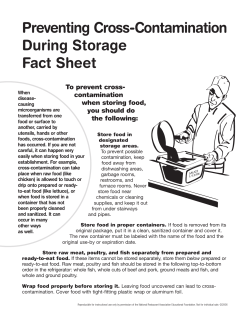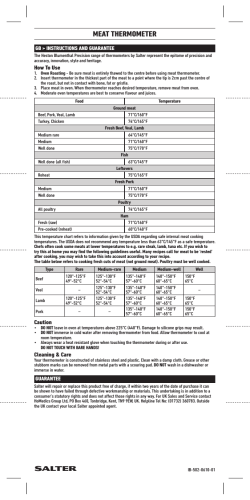
Leftovers and Food Safety Food Safety Information
PhotoDisc United States Department of Agriculture Food Safety and Inspection Service Food Safety Information Leftovers and Food Safety Often when we cook at home or eat in a restaurant, we have leftovers. Safe handling of leftovers is very important to reducing foodborne illness. “How long can I keep leftovers in the refrigerator?” “To what temperture should I reheat leftovers?” “If I thaw leftovers, can I refreeze them?” To answer these questions and others, follow the USDA Food Safety and Inspection Service’s recommendations for handling leftovers safely. Cook Food Safely at Home The first step in having safe leftovers is cooking the food safely in the first place. Use a food thermometer to make sure that the food is cooked to a safe, minimum internal temperature. • Red meats: Cook all raw beef, pork, lamb and veal steaks, chops, and roasts to a minimum internal temperature of 145 °F as measured with a food thermometer before removing meat from the heat source. For safety and quality, allow meat to rest for at least three minutes before carving or consuming. For reasons of personal preference, consumers may choose to cook meat to higher temperatures. • Ground meats: Cook all raw ground beef, pork, lamb, and veal to an internal temperature of 160 °F as measured with a food thermometer. • Poultry: Cook all poultry to an internal temperature of 165 °F as measured with a food thermometer. Keep Food out of the “Danger Zone” Bacteria grow rapidly between the temperatures of 40° F and 140° F. After food is safely cooked, hot food must be kept hot at 140° F or hotter to prevent bacterial growth. Within 2 hours of cooking food or holding it hot, leftovers must be refrigerated. Throw away all perishable foods that have been left at room temperature for more than 2 hours (1 hour if the temperature is over 90° F, such as at an outdoor picnic during summer). Cold perishable food, such as chicken salad or a platter of deli meats, should be kept at 40° F or below. When serving food at a buffet, keep food hot in chafing dishes, slow cookers, or warming trays. Keep food cold by nesting dishes in bowls of ice or use small serving trays and replace them often. Cool Food Rapidly To prevent bacterial growth, it’s important to cool food rapidly so it reaches as fast as possible the safe refrigerator-storage temperature of 40° F or below. To do this, divide large amounts of food into shallow containers. A big pot of soup, for example, will take a long time to cool, inviting bacteria to multiply and increasing the danger of foodborne illness. Instead, divide the pot of soup into smaller containers so it will cool quickly. For whole roasts or hams, slice or cut them into smaller parts. Cut turkey into smaller pieces and refrigerate. Slice breast meat; legs and wings may be left whole. Hot food can be placed directly in the refrigerator or be rapidly chilled in an ice or cold water bath before refrigerating. Wrap Leftovers Well Cover leftovers, wrap them in airtight packaging, or seal them in storage containers for storage in the refrigerator. These practices help keep bacteria out, retain moisture, and prevent leftovers from picking up odors from other food in the refrigerator. Immediately refrigerate or freeze the wrapped leftovers for rapid cooling. Store Leftovers Safely Leftovers can be kept in the refrigerator for 3 to 4 days or frozen (0° F or below) for 3 to 4 months. Although safe indefinitely, frozen leftovers can lose moisture and flavor when stored for longer times in the freezer. The Food Safety and Inspection Service (FSIS) is the public health agency in the U.S. Department of Agriculture responsible for ensuring that the nation’s commercial supply of meat, poultry, and egg products is safe, wholesome, and correctly labeled and packaged. USDA Meat & Poultry Hotline 1-888-MPHotline (1-888-674-6854) Leftovers and Food Safety Thaw Frozen Leftovers Safely Reheat Leftovers Safely Safe ways to thaw leftovers include the refrigerator, cold water and the microwave oven. Refrigerator thawing takes the longest but is safest the leftovers stay safe the entire time. After thawing, the food should be used within 3 to 4 days or can be refrozen. When reheating leftovers, be sure they reach 165° F as measured with a food thermometer. Reheat sauces, soups and gravies by bringing them to a rolling boil. Cover leftovers to reheat. This retains moisture and ensures that food will heat all the way through. Cold water thawing is faster than refrigerator thawing but requires more attention. The frozen leftovers should be placed in a leak-proof package or plastic bag. If the bag leaks, water can get into the food and bacteria from the air or surrounding environment could enter the packaging bag. Change the water every 30 minutes to promote fast thawing. Food thawed by the cold water method should be reheated before refreezing. When reheating in the microwave, cover and rotate the food for even heating. Arrange food items evenly in a covered microwave safe glass or ceramic dish, and add some liquid if needed. Be sure the covering is microwave safe, and vent the lid or wrap to let the steam escape. The moist heat that is created will help destroy harmful bacteria and will ensure uniform cooking. Microwaves can cook unevenly and leave “cold spots” where harmful bacteria can survive. Always allow a stand time to complete the cooking and before checking with a food thermometer. Microwave thawing is the fastest method. When thawing leftovers in a microwave, reheat the food until it reaches 165° F as measured with a food thermometer. Foods thawed in the microwave can be refrozen after heating it to this safe temperature. Reheating Leftovers without Thawing It is safe to reheat frozen leftovers without thawing them first. Frozen leftovers can be reheated in a saucepan, microwave, or in the oven. Reheating will take longer than if the food is thawed first, but it is safe to do when time is short. Refreezing Previously Frozen Leftovers Sometimes there are leftover “leftovers.” It is safe to refreeze any food remaining after reheating previously frozen leftovers to the safe temperature of 165° F as measured with a food thermometer. If a large container of leftovers was frozen and only a portion of it is needed, it is safe to thaw the leftovers in the refrigerator, remove the needed portion, and refreeze the remainder of the thawed leftovers without reheating it. Food Safety Questions? Call the USDA Meat & Poultry Hotline If you have a question about meat, poultry, or egg products, call the USDA Meat and Poultry Hotline toll free at 1-888-MPHotline (1-888-674-6854). The hotline is open Monday through Friday from 10 a.m. to 4 p.m. ET (English or Spanish). Recorded food safety messages are available 24 hours a day. Check out the FSIS Web site at www.fsis.usda.gov Send E-mail questions to [email protected]. FSIS encourages the reprint and distribution of this publication for food safety purposes. However, the included image from PhotoDisc, used under license, is protected by the copyright laws of the U.S., Canada, and elsewhere, and may not be saved or downloaded except for printing of this publication. AskKaren.gov FSIS’ automated response system can provide food safety information 24/7 and a live chat during Hotline hours. Mobile phone users can access m.askkaren.gov PregunteleaKaren.gov The USDA is an equal opportunity provider and employer. Revised May 2012
© Copyright 2025









